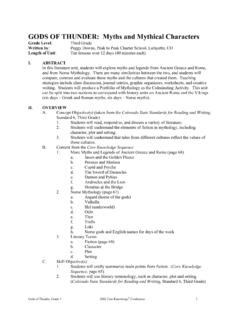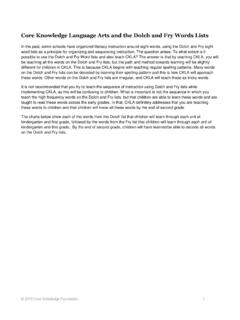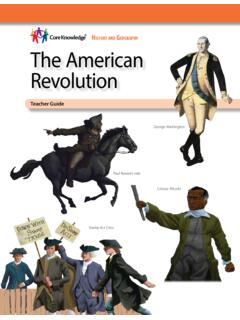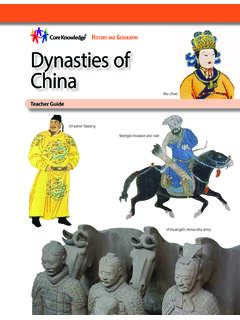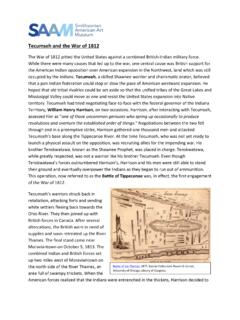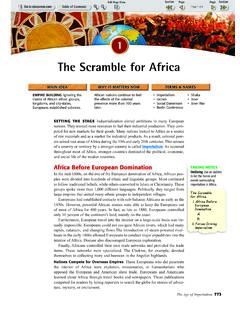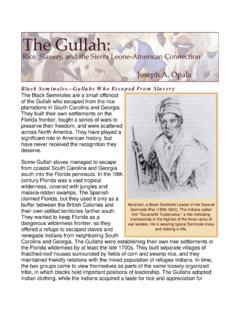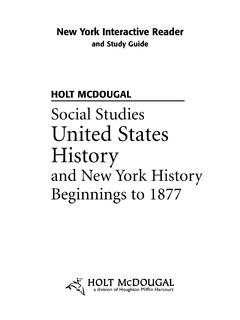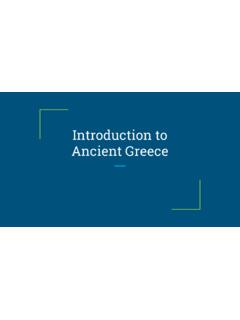Transcription of History and GeoGrapHy Maya, Aztec, and Inca Civilizations
1 maya , aztec , and Inca CivilizationsTeacher GuideHistory and GeoGrapHySapa Inca aztec warriorMoctezuma IIMaya pyramids maya , aztec , and Inca CivilizationsTeacher GuideISBN: 978-1-68380-027-9 Creative Commons LicensingThis work is licensed under a Creative Commons Attribution-NonCommercial-ShareAlike International are free:to Share to copy, distribute, and transmit the work to Remix to adapt the work Under the following conditions:Attribution You must attribute the work in the following manner:This work is based on an original work of the Core Knowledge Foundation ( ) made available through licensing under a Creative Commons Attribution-NonCommercial-ShareAlike International License. This does not in any way imply that the Core Knowledge Foundation endorses this You may not use this work for commercial purposes. Share Alike If you alter, transform, or build upon this work, you may distribute the resulting work only under the same or similar license to this one.
2 With the understanding that: For any reuse or distribution, you must make clear to others the license terms of this work. The best way to do this is with a link to this web page: 2016 Core Knowledge Foundation Rights Knowledge , Core Knowledge Curriculum Series , Core Knowledge History and GeoGrapHy and CKHG are trademarks of the Core Knowledge and trade names are shown in this book strictly for illustrative and educational purposes and are the property of their respective owners. References herein should not be regarded as affecting the validity of said trademarks and trade , aztec , and Inca CivilizationsTable of ContentsIntroduction .. 1 maya , aztec , and Inca Civilizations Sample Pacing Guide .. 14 Chapter 1 The maya : Rainforest civilization .. 16 Chapter 2 maya Science and Daily Life ..30 Chapter 3 The aztec : Empire Builders .. 38 Chapter 4 Tenochtitl n: City of Wonder .. 45 Chapter 5 The Inca: Lords of the Mountains.
3 52 Chapter 6 Inca Engineering .. 59 Chapter 7 The End of Two Empires ..67 Teacher Resources ..77 maya , aztec and Inca CivilizationsTeacher GuideCore Knowledge Sequence History and GeoGrapHy 51 INTRODUCTIONUNIT 2 IntroductionAbout this unitThe Big IdeaThe maya , aztec , and Inca had developed large, complex Civilizations prior to the arrival of the Civilizations of the maya , aztec , and Inca that once flourished in Central and South America shared common elements. People practiced farming, developed social structures, raised armies, and worshipped many gods. The three Civilizations were as diverse as the terrains in which they lived. The maya , known for developing a system of mathematics, thrived in the rainforests of the Yucat n Peninsula, Belize, Honduras, and Guatemala from about 200 to 900 CE. From 1325 to 1521, the aztec built a large and dense city at Tenochtitl n, located on a swampy lake in the middle of a semi-arid basin in central Mexico.
4 The Inca were skilled engineers who built a vast system of roads and bridges to unite their empire located high in the Andes Mountains, reaching their peak in the 1400s and early remains in question why and how the rainforest cities of the Classic maya fell. We know that Spanish explorers precipitated the destruction of both the aztec and Inca empires. 2 maya , aztec , AND INCA CIVILIZATIONSWhat Students Should Already KnowStudents in Core Knowledge schools should be familiar with:Kindergarten The voyage of Columbus in 1492 -Queen Isabella and King Ferdinand of Spain -The Ni a, Pinta, and Santa Maria -Columbus s mistaken identification of Indies and Indians -The idea of what was, for Europeans, a New World Grade 1 maya , aztec , and Inca Civilizations -The development by the maya of large population centers in the rainforests of Mexico and Central America -The establishment of a vast empire in central Mexico by the aztec , its capital of Tenochtitl n, and its emperor Moctezuma (Montezuma) -The Inca s establishment of a far-ranging empire in the Andes Mountains of Peru and Chile, including Machu Picchu Columbus The conquistadors -The search for gold and silver Hern n Cort s and the aztec Francisco Pizarro and the Inca Diseases devastate Native American populationGrade 2 The GeoGrapHy of South America -Brazil: largest country in South America, Amazon river , rainforests -Peru and Chile: Andes Mountains -Locate.
5 Venezuela, Colombia, Ecuador -Bolivia: named after Sim n Bol var, The Liberator -Argentina: the Pampa (also known as the Pampas) -Main languages: Spanish and (in Brazil) Portuguese3 INTRODUCTIONTime Period BackgroundThe items below refer to content in Grade 5. Use a classroom timeline with students to help them sequence and relate events from different periods and 1500 BCE Earliest Mesoamerican villagesc. 200 900 CEPeak of maya civilizationc. 1300sBeginning of aztec Empirec. 1300sBeginning of Inca Empire14 0 0 sFirst cargo of enslaved people from Africa brought by Portuguese to their colonies1492 Columbus s first voyage to the Americas1496 Santo Domingo on Hispaniola founded as first permanent Spanish settlement in Americas150 0sSpanish brought the first cargo of enslaved Africans to Hispaniola1513 Balboa discovers the Pacific Ocean1517 Luther initiates Protestant Reformation1517 Ponce de Le n lands in Florida1519 21 Magellan circumnavigates the globe1521 Conquest of the aztec by Cort s1534 Conquest of the Inca by Pizarro1534 Cartier of France explores the St.
6 Lawrence River1535 Most of central Mexico in Spanish hands1539 42De Soto explores North America154 0 Most of Peru under Spanish control 1545 65 Major silver discoveries in Mexico and Peruc . 1570 End of era of conquistadorsWhat Students Need to Learn Identify and locate Central America and South America on maps and globes -Largest countries in South America: Brazil and Argentina Amazon river Andes Mountains The maya -Ancient maya lived in what is now southern Mexico and parts of Central America; their descendants still live there today -Accomplishments as architects and artisans: pyramids and temples -Development of a system of hieroglyphic writing -Knowledge of astronomy and mathematics; use of a 365-day calendar; early use of the concept of zero The aztec -At its height in the 1400s and early 1500s, the aztec empire covered much of what is now central Mexico -The island city of Tenochtitl n: aqueducts, massive temples, etc. -Moctezuma (also spelled Montezuma) -Ruler-priests; practice of human sacrifice The Inca -Ruled an empire stretching along the Pacific Coast of South America -Built great cities (Machu Picchu, Cuzco) high in the Andes, connected by a system of roads Conquistadors: Cort s and Pizarro -Advantages of Spanish weaponry (guns and cannons) -Devastation of native peoples by European diseases4 maya , aztec , AND INCA CIVILIZATIONSAt A GlAnceThe most important ideas in Unit 2 are: Students should be able to locate Mexico, Central America, South America, and the major countries, rivers, and mountain chain in South America on maps and globes.
7 Mesoamerica is a cultural area that covers central and southern Mexico as well as northern Central America. The maya people constructed large monumental buildings, created a hieroglyphic writing system, employed a 365-day calendar, and developed the concept of zero. The aztec dominated central and southern Mexico through force and a tribute system. The Inca developed a widespread empire in the Andes Mountains linked by a network of roads. Both the aztec and the Inca empires were conquered by Spanish conquistadors; the aztec Empire was conquered by Cort s, and the Inca Empire was defeated by Pizarro. The Spanish had an advantage over native peoples because the former had guns, cannons, and horses. European diseases killed thousands of native peoples, who had no natural immunity against teAchers need to KnoWGeography Related to Central and South AmericaCentral America is part of North America and contains the countries of Belize, Costa Rica, El Salvador, Guatemala, Honduras, Nicaragua, and Panama.
8 It is bordered by the Caribbean Sea to the east and by the Pacific Ocean to the west. To the south is the continent of South America. Central America is an isthmus, or land bridge, that connects the two larger bodies of land. South America is the fourth largest continent. To the east is the Atlantic Ocean, and to the west, the Pacific Ocean. The Caribbean Sea borders South America to the north. The Andes Mountains range from north to south on the far western side of South America. The northern portion of the continent, including much of Brazil, is covered by tropical covers almost half of the South American continent and is the fifth largest country in the world. Brazil is so large that it borders all but two (Chile 5 INTRODUCTIONand Ecuador) of the other twelve countries in South America. The word Brazil comes from the name of a tree found in the Amazon rainforest. Brazil lies mostly within the tropical zone, so its climate is mainly warm and of the people live in urban areas, and about thirty percent of the population lives on the coastal plain, a narrow strip along the Atlantic Ocean.
9 About seven hundred thousand native people live within the rainforest, but many others live in cities and urban areas. The overall population is a mix of descendants of Portuguese, native peoples, and Africans. Brazil was conquered by Portugal, unlike most of South America, which was conquered by the Spanish. Its official language is is the second largest country in South America. A long, narrow country, Argentina extends east and south of the Andes and south of Paraguay and Uruguay. The Andes form the boundary between Argentina and Chile. The Gran Chaco, a region of low forests and grasslands, dominates Argentina s northern region. The south is a collection of barren plateaus, known as Patagonia. The major economic area of Argentina is the Pampa (also known as the Pampas) in the center of the country. This region of tall grasslands and temperate climate is famous for its cattle ranches. About seventy percent of the population lives in this Argentines are descendants of Spanish colonists, and Spanish is the official RiverThe Amazon river forms at the junction of the Ucayali (/ooh*cah*yah*lee/) and Mara n (/marn*yeown/) Rivers in northern Peru and empties into the Atlantic Ocean through a delta in northern Brazil.
10 The Amazon is the second longest river in the world after the Nile but has the largest volume of water of any river in the world. Hundreds of tributaries feed into it. The Amazon river basin drains more than forty percent of South America. With no waterfalls, the river is navigable for almost its entire Amazon flows through the world s largest rainforest. This rainforest is home to more than million species of insects, tens of thousands of plants, and over one thousand species of birds. In fact, almost half of all of the world s known species can be found in the Amazon. Mammals in the Amazon rainforests include the tapir (a hoofed mammal), the nutria (an otter-like creature), the great anteater, and various kinds of monkeys. Insects include large, colorful butterflies. Birds include hummingbirds, toucans, and parrots. A famous reptile dweller is the anaconda, a huge snake that squeezes its victims to death; alligators are also common. Fish include flesh-eating piranhas and the electric eel, capable of discharging a shock up to 650 volts.
